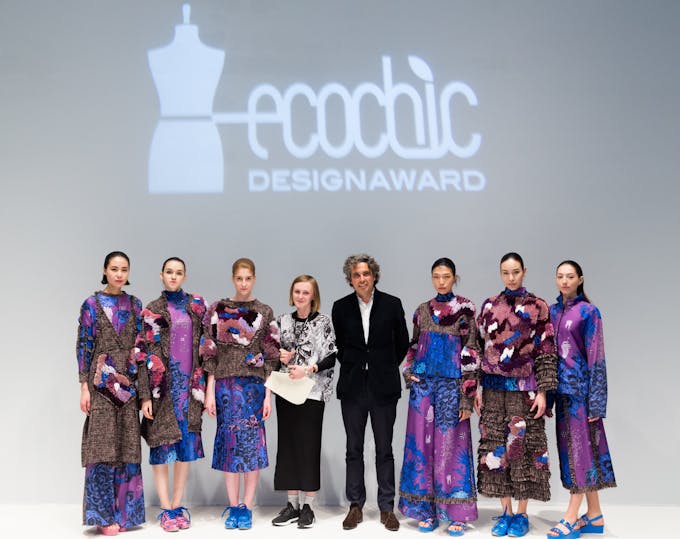The fashion world was treated to a spectacular show last month in Paris by German fashion designer Karl Lagerfeld and Chanel’s “ecology-themed” spring extravaganza, a couture presentation of “environmental” high fashion surrounded by a “natural” setting of a wooden pavilion, lush grass for the runway, and matching neutral tones for the fabrics.
To continue reading, subscribe to Eco‑Business.
There's something for everyone. We offer a range of subscription plans.
- Access our stories and receive our Insights Weekly newsletter with the free EB Member plan.
- Unlock unlimited access to our content and archive with EB Circle.
- Publish your content with EB Premium.
Much as it attempted to bring ecological concerns to the stage, what Lagerfeld seems to have achieved was far less green. Industry critics noted that the house was built from new materials, and that no mention was made of any of the couture pieces being created from sustainable, recycled nor ethical sources.
For some, the show by the French fashion giant failed to raise awareness of environmental issues to the rarefied audience of couture fashion and the media that report it. In fact, it looked like another exercise in greenwashing.
“
As fashion blogger Outi Les Pyy put it, “using wooden beads, a grass runway and zen birds does not make a brand or collection ecological or [green]”.
What the show did bring to light, however, is the need for consumers to be careful about the marketing that surrounds products that are touted as “green” and “eco-friendly”.
As fashion blogger Outi Les Pyy put it, “using wooden beads, a grass runway and zen birds does not make a brand or collection ecological or [green]”.
There are many approaches a fashion company can take to be environmentally and socially responsible.
For example, in 2015, denim fashion giant Levi Strauss announced an overhaul of their business operations that involved ensuring the sustainability of the company on all fronts, from the sourcing of materials to manufacturing of their products as well as an employee programme that provides opportunities for volunteering efforts.
In 2014, in an unprecedented move, retailer H&M entered into a partnership with the United Nations International Labour Organisation that seeks to uphold and protect the rights and welfare of all those who work in their factories.
And even before “eco-fashion” became a buzzword, Esprit had already been offering organic cotton apparel since 1992, and their recent Recycled Collection featuring apparel made with off-cuts from manufacturing textiles reflects their ongoing commitment to the sustainability cause.
It isn’t just fashion conglomerates who are making the effort; smaller retailers are also providing more responsible fashion options. Boutiques such as Sévya, Raven + Lily and Purple Impression are just a few of many smaller operations that source materials responsibly and maintain ethical standards for their employees.

Winner Patrycja Guzik (fourth from left) at the 2016 EcoChic Awards, an annual Redress event that seeks to inspire young designers to create cutting edge fashion with sustainability in mind. Image: Redress
The emergence of websites such as Shop Ethica and Kaight is also a response to the increasing need for online resources that curate the recent proliferation of eco-fashion sites for a more efficient consumer shopping experience.
Environmental NGOs such as Redress, based in Hong Kong, have contributed to raising the sustainability standards of the fashion industry by educating and nurturing young designers as well as engaging businesses to embrace responsible practices.
For the mindful consumer, eco-fashion is the answer to their desire to dress responsibly. The deluge of new terms, however, can seem confusing or vague, especially because some of these are not regulated nor standardised.
So, here’s our guide to help you navigate the jargon-heavy world of eco-fashion:
Broad terms:
- eco-fashion/sustainable fashion - These two terms are often used interchangeably to mean a comprehensive philosophy in fashion that encompasses all facets of clothes production, with an emphasis on the “closed circle” model of production where products are made only from renewable resources and are recyclable.
- ethical fashion - An aspect of ecofashion, it refers to the welfare and rights of employees are ensured and protected
- vegan fashion - These are products that avoid the use of animal sources and animal by-products
- craft/artisan fashion - The production numbers in this type of fashion are highly limited and usually involve skills (such as embroidery) that have historical and cultural meaning
- upcycling - This is the transformation of previously unwanted or discarded resources into a viable product of greater value and higher quality
Verifiable and regulated terms:
- Fair trade certified - Apparel and accessories that have the Fair Trade stamp are made without exploitation of labour and companies who seek the certification must prove that their workers are paid and treated fairly.
- Global Organic Textile Standard (GOTS) - Products that are GOTS certified are made from organic fibres that have been grown without the use of GMO seeds and are also made on facilities that use water efficiently and treat waste responsibly.
- OEKO-TEX Standard 100 - This testing and certification system is similar to the GOTS and ensures that the product is made with adherence to health standards without the use of harmful substances and chemicals.
- European Eco-Label for Textile Products - This is a standard that guarantees not just that a product was made with environmentally responsible methods, it is also shrink-resistant and colour-fast.
Marketing terms:
The common usage of terms such as “green”, “natural” and “environmentally friendly” are catch-all expressions to describe ecologically sound products, but are not specific in the ways they actually are so. In other words, labels that say “green” but do not include ways of verifying how so may or may not be sustainable, ethical or ecological in any way.
Interested in finding out more? Here are some resources to help you.
- List of sustainable clothing stores in Singapore at Little Green Dot
- Ethical apparel boutiques in the Asia Pacific region at Asia For Good
- International shopping for Fair Trade apparel at The Good Trade
- One Green Planet breaks down the claims made by different ecofashion brands
- Some pointers on how to shop ethically from HuffPost Style

















